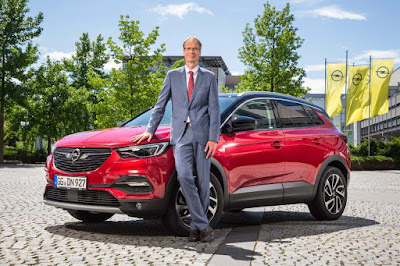- Opel Grandland X SUV and hybrid version to be produced in Eisenach
- Development of next generation global Groupe PSA 1.6-litre engine family (EP) at Engineering Center in Rüsselsheim
- Framework agreement with job protection extended until 2023
 |
| Announcement: Opel CEO Michael Lohscheller announced that the Opel Grandland X SUV will be built in Eisenach as of mid-2019. |
Opel has now also secured its future in Germany and is taking a
further step on its way to becoming profitable, global and electric.
Significant investments will be made in R&D and the sites in
Eisenach, Rüsselsheim and Kaiserslautern between 2018 and 2023. As part
of this investment, the Opel Grandland X will be produced in the Eisenach
plant as of mid-2019 in two shifts, including a hybrid version which
will follow in 2020. The company will announce details on the planned
investments for the other German sites at a later date.
The negotiating parties also agreed on a further important step to
define the Engineering Center in Rüsselsheim’s future role in the global
Groupe PSA R&D network: The Engineering Center in Rüsselsheim will
be responsible for the development of the next generation EP engine
family. Previously, the Engineering Center in Rüsselsheim had already
received global responsibilities for Groupe PSA with the allocation of
15 Centers of Competence. Furthermore, every future European Opel model
will be developed in Rüsselsheim.
The carmaker also agreed on a new framework agreement with the social
partners. It runs until July 2023 and includes an extensive package of
measures to increase competitiveness. The exclusion of forced
redundancies has been extended for the duration of the new agreement.
“This is a very important step in the implementation of the PACE!
plan to make Opel fit for performance across Europe. And we are doing
exactly what we promised. The increase of the competiveness is allowing
us to invest and secure a good future for our people,” said Opel CEO
Michael Lohscheller. “We are looking ahead after delivering on our
commitment to not close any plants or announce any forced redundancies.”
“We will ensure long-term utilisation of our German sites and thus
protect employment – and this well into the next decade – with
attractive models and high-quality components,” said Lohscheller. “We
are deeply rooted in Germany and our German plants are and will remain
our backbone.”
Measures to improve the competitiveness of Opel in Germany are part
of the new agreement. Balancing collective wage increases with
remuneration components above the general pay scale shall be possible in
future. Furthermore, the additional payments agreed within the scope of
the IG Metall collective agreement, which would be applicable as of
mid-2019, have been cancelled for the duration of the new framework
agreement. Any potential further wage increases as of 2020 will be
postponed in their effectiveness for the duration of the contract.
 |
| Successful SUV: Opel Grandland X will roll off the production line in Eisenach as of mid-2019. |
Part of the agreement is also the departure of 3,700 employees in Germany based on the already successfully implemented voluntary programme approved by the social partners. Today, around 3,500 employees have already taken advantage of a voluntary programme.
“The measures agreed today are a further important milestone on the
way to achieving the objectives of our PACE! strategic plan: To reach a
recurring operating margin of two percent by 2020 and six percent by
2026,” said Opel CEO Michael Lohscheller. “We are grateful for the
important contribution of our German employees to making Opel successful
again,” added Lohscheller. “The intensive negotiations have been
brought to a positive conclusion. I would explicitly like to thank our
social partners for this.”











